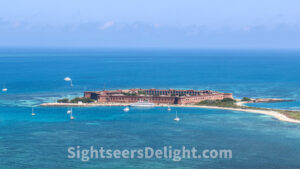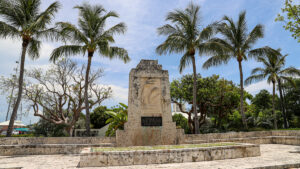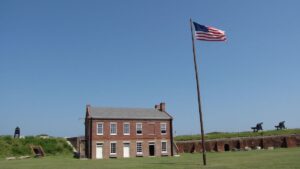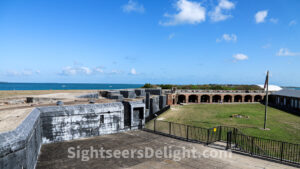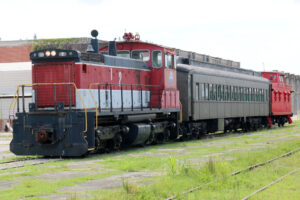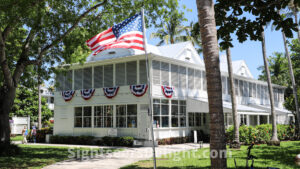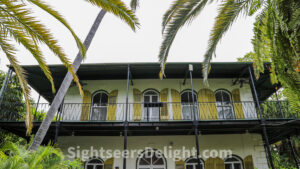Located off of Interstate 75 in Ocala, Florida, the Don Garlits Museum of Drag Racing features an amazing array of cars and vintage engines Garlits has rebuilt for display. Garlits’ impact on the sport is immeasurable. He was the first driver to officially surpass a number of speed marks, including hitting 270 mph on a quarter-mile track and 200 mph on a 1/8-mile track. Artifacts that help tell the story of drag racing’s history are featured throughout. Highlights include the Swamp Rat I, the car Garlits raced when he set his first world record; the Swamp Rat 14, the first rear engine car Garlits built; and the Swamp Rat 34.
34473
Dry Tortugas National Park, situated about 68 miles west of Key West, preserves Fort Jefferson and the seven Dry Tortugas islands, the westernmost and most isolated Florida Keys. Fort Jefferson, a massive but unfinished coastal fortress, is the largest brick masonry structure in the Western Hemisphere and includes more than 16 million bricks. The park, accessible by seaplane and boat, is popular for its abundant sea life, tropical bird breeding grounds and colorful coral reefs. Dry Tortugas National Park is part of the Everglades & Dry Tortugas Biosphere Reserve, which UNESCO established in 1976 under its Man and the Biosphere Programme.
Everglades National Park was dedicated in Everglades City, Florida, on Dec. 6, 1947. It is famous for its unique ecosystem: wetlands, sawgrass marshes, cypress swamps, and mangrove forests. It is home to a diverse array of plant and animal species, including endangered species like the Florida panther and the manatee and rare species like the American crocodile. Visitors can explore the park’s many hiking trails, canoe and kayak along its waterways, take an airboat tour, or participate in ranger-led programs and educational activities. The park is also a popular destination for birdwatching, fishing, and camping.
This post incorporates text generated with GPT-3, OpenAI’s large-scale language-generation model.
33034
The Fernandina Beach Marine Welcome Center & Shrimping Museum gives visitors to Amelia Island a quick overview of the shrimping industry and its impact on the region. The Amelia Island Museum of History began running the museum after the city of Fernandina Beach approached the museum in 2010. The small museum, located on the waterfront in downtown Fernandina Beach, includes information about the shrimping industry and the families who played a vital role in its development. Theor efforts helped make the state “the birthplace of the modern shrimping industry.”
32034
The Florida Keys Memorial, also known as the Hurricane Monument, is a landmark located in Islamorada, Florida. The monument was constructed to honor the hundreds of victims of the devastating Labor Day Hurricane of 1935, which caused widespread destruction and loss of life in the Florida Keys. The 81-foot-tall memorial is made of native keystone.
This post partially incorporates text generated with GPT-3, OpenAI’s large-scale language-generation model.
33036
Construction on Fort Clinch started in 1847 after the Second Seminole War on a peninsula near Amelia Island’s northernmost point. The only battle at the fort, named in honor of General Duncan Lamont Clinch, a leader in the First and Second Seminole Wars, happened during the Civil War. In 1862, Union troops recaptured the fort after Confederates seized control of the structure. The state of Florida bought the fort in 1935. Today, the fort is part of the 1,100-acre Fort Clinch State Park, which opened to the public in 1938.
32034
Fort Zachary Taylor Historic State Park, located near the southern tip of Key West, Florida. It was placed on the National Register of Historic Places in 1971 and designated a National Historic Landmark in 1973. Construction of the fort began in 1845. The fort was built as part of a mid-19th century plan to defend the southeast coast following the War of 1812. Though it has been modified over the years, Fort Zachary Taylor was used during the 1898 Spanish–American War, World War I, World War II and the Cuban Missile Crisis.
The Gold Coast Railroad Museum, founded in 1956 and located in the former Naval Air Station Richmond (NASR), is one of Florida’s official state railroad museums. It houses a valuable collection of exhibits, including the Ferdinand Magellan. This observation car was built by the Pullman Company in 1929 and served as the Presidential Rail Car between 1943 and 1958.
The Harry S. Truman Little White House in Key West, Florida, is a historic building that served as the winter White House of President Harry S. Truman during his presidency. Originally built in 1890 as the naval station’s command headquarters during the Spanish-American War, it was later used as a vacation home by several presidents before Truman. The house is now a museum that is open to the public for tours, which offer visitors a glimpse into the life of Truman and other presidents who stayed at the house. The museum features exhibits, artifacts, and photographs that highlight the history of the house and its famous occupants.
This post incorporates text generated with GPT-3, OpenAI’s large-scale language-generation model.
33040
Pulitzer and Nobel Prize-winning author Ernest Hemingway and his wife, Pauline Pfeiffer, lived in a house at 907 Whitehead Street from 1931 to 1939. Asa Tift, a marine architect and salvage wrecker, built the house in a French Colonial estate style. Construction on the house started in 1848 and completed in 1851. When Pauline first saw the house in deep disrepair, she labeled it a “damned haunted house.” However, she convinced her wealthy uncle to buy it for $8,000 for her and her husband as a wedding present. Today, the Ernest Hemingway Home and Museum in Key West, Florida, is equal parts shrine to Hemingway and a historic house. The house, a National Historic Landmark, showcases Hemingway’s possessions, including his writing desk, hunting trophies and books. It is also famous for its resident cats, many of which are descendants of Hemingway’s original pet cats and are said to have six toes.
33040

